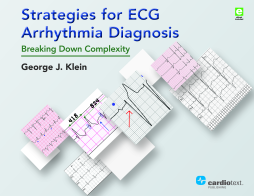
BOOK
Strategies for ECG Arrhythmia Diagnosis
George J. Klein | Lorne J. Gula | Peter Leong-Sit
(2016)
Additional Information
Book Details
Abstract
The ECG remains the cornerstone of arrhythmia diagnosis, even after an explosion of technology and rapid expansion of our understanding of arrhythmia mechanisms. While many traditional textbooks emphasize cataloguing arrhythmias and pattern recognition, this book by internationally recognized professor George J. Klein, MD, presents a universally applicable systematic approach to ECG arrhythmia diagnosis based on careful measurement and identification of key events and exploring their expected electrophysiological underpinnings. There is fundamentally no difference in the principles and strategies behind understanding the ECG and intracardiac tracings—both are absolutely complementary.
Over 90 case studies with tracings in full landscape format are used to highlight important principles, with each case providing an important diagnostic “tip” or teaching point.
A multiple-choice question is provided with each tracing not only to “frame the problem” for the reader but to provide some practice and strategies for answering cardiology board examination-type questions.
An important book that paves the way to understanding ECGs when preparing for board or certification exams.
The book is meant for serious students of arrhythmias, be they cardiology or electrophysiology trainees or established physicians.
Table of Contents
| Section Title | Page | Action | Price |
|---|---|---|---|
| Cover | i | ||
| Copyright | vi | ||
| Table of Contents | vii | ||
| Contributors | ix | ||
| Preface | xi | ||
| Abbreviations | xiii | ||
| Explanatory Notes and Tables of Differential Diagnosis | xv | ||
| Chapter 1: The Electrophysiological Approach to ECG Diagnosis | 1 | ||
| Chapter 2: Diagnosis Through Physiology | 7 | ||
| Chapter 3: The Narrow QRS Tachycardia | 55 | ||
| Chapter 4: The Wide QRS Tachycardia | 117 | ||
| Chapter 5: The Rhythm Strip | 191 | ||
| Chapter 6: The Irregular Tachycardia | 237 | ||
| Chapter 7: Application of Strategies: Further Practice | 293 | ||
| Index | 351 |
